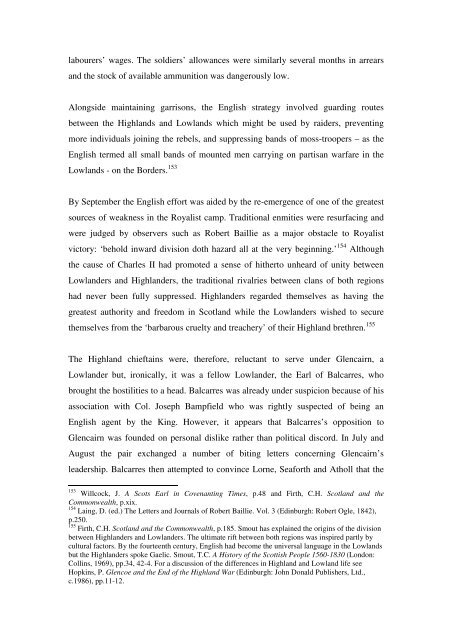The Glencairn Uprising, 1653-54 Helen Baker Department of ...
The Glencairn Uprising, 1653-54 Helen Baker Department of ...
The Glencairn Uprising, 1653-54 Helen Baker Department of ...
You also want an ePaper? Increase the reach of your titles
YUMPU automatically turns print PDFs into web optimized ePapers that Google loves.
labourers’ wages. <strong>The</strong> soldiers’ allowances were similarly several months in arrears<br />
and the stock <strong>of</strong> available ammunition was dangerously low.<br />
Alongside maintaining garrisons, the English strategy involved guarding routes<br />
between the Highlands and Lowlands which might be used by raiders, preventing<br />
more individuals joining the rebels, and suppressing bands <strong>of</strong> moss-troopers – as the<br />
English termed all small bands <strong>of</strong> mounted men carrying on partisan warfare in the<br />
Lowlands - on the Borders. 153<br />
By September the English effort was aided by the re-emergence <strong>of</strong> one <strong>of</strong> the greatest<br />
sources <strong>of</strong> weakness in the Royalist camp. Traditional enmities were resurfacing and<br />
were judged by observers such as Robert Baillie as a major obstacle to Royalist<br />
victory: ‘behold inward division doth hazard all at the very beginning.’ 1<strong>54</strong> Although<br />
the cause <strong>of</strong> Charles II had promoted a sense <strong>of</strong> hitherto unheard <strong>of</strong> unity between<br />
Lowlanders and Highlanders, the traditional rivalries between clans <strong>of</strong> both regions<br />
had never been fully suppressed. Highlanders regarded themselves as having the<br />
greatest authority and freedom in Scotland while the Lowlanders wished to secure<br />
themselves from the ‘barbarous cruelty and treachery’ <strong>of</strong> their Highland brethren. 155<br />
<strong>The</strong> Highland chieftains were, therefore, reluctant to serve under <strong>Glencairn</strong>, a<br />
Lowlander but, ironically, it was a fellow Lowlander, the Earl <strong>of</strong> Balcarres, who<br />
brought the hostilities to a head. Balcarres was already under suspicion because <strong>of</strong> his<br />
association with Col. Joseph Bampfield who was rightly suspected <strong>of</strong> being an<br />
English agent by the King. However, it appears that Balcarres’s opposition to<br />
<strong>Glencairn</strong> was founded on personal dislike rather than political discord. In July and<br />
August the pair exchanged a number <strong>of</strong> biting letters concerning <strong>Glencairn</strong>’s<br />
leadership. Balcarres then attempted to convince Lorne, Seaforth and Atholl that the<br />
153 Willcock, J. A Scots Earl in Covenanting Times, p.48 and Firth, C.H. Scotland and the<br />
Commonwealth, p.xix.<br />
1<strong>54</strong> Laing, D. (ed.) <strong>The</strong> Letters and Journals <strong>of</strong> Robert Baillie. Vol. 3 (Edinburgh: Robert Ogle, 1842),<br />
p.250.<br />
155 Firth, C.H. Scotland and the Commonwealth, p.185. Smout has explained the origins <strong>of</strong> the division<br />
between Highlanders and Lowlanders. <strong>The</strong> ultimate rift between both regions was inspired partly by<br />
cultural factors. By the fourteenth century, English had become the universal language in the Lowlands<br />
but the Highlanders spoke Gaelic. Smout, T.C. A History <strong>of</strong> the Scottish People 1560-1830 (London:<br />
Collins, 1969), pp.34, 42-4. For a discussion <strong>of</strong> the differences in Highland and Lowland life see<br />
Hopkins, P. Glencoe and the End <strong>of</strong> the Highland War (Edinburgh: John Donald Publishers, Ltd.,<br />
c.1986), pp.11-12.
















